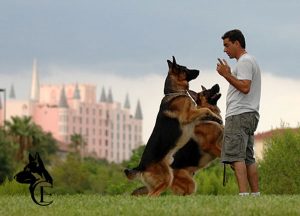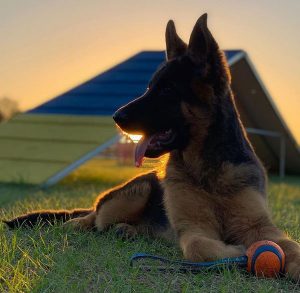Having a new German shepherd in the home can be a fun and thrilling experience. However, when welcoming a new German Shepherd into the house, many questions come into play. One of the main questions is in regards to training your dog and where to begin. Whether its food, praise, toy, or all three, it’s essential to secure a reward that fits your training style and your dog enjoy. One of the methods that Canine Extreme likes to use when training is rewarding with a toy.
Understanding Training Drives in German Shepherds
 Working and training with your dog is a fun and exhilarating experience for both the dog and the trainer. The use of positive reinforcement for training is the go-to method for Canine Extreme. When training with positive reinforcement, it’s essential to know what “drives” are and how you can utilize them to aid in your dog’s training. The term “drive” can be generalized as an instinct that coaxes the dog into performing a specific behavior. A great example of this would be the use of a ball on a rope to gain the attention and excitement of a puppy. With an accurate understanding of a few critical drives, we can employ them to make positive reinforcement training a fun, practical, exciting, and overall enjoyable experience for both the dog and trainer.
Working and training with your dog is a fun and exhilarating experience for both the dog and the trainer. The use of positive reinforcement for training is the go-to method for Canine Extreme. When training with positive reinforcement, it’s essential to know what “drives” are and how you can utilize them to aid in your dog’s training. The term “drive” can be generalized as an instinct that coaxes the dog into performing a specific behavior. A great example of this would be the use of a ball on a rope to gain the attention and excitement of a puppy. With an accurate understanding of a few critical drives, we can employ them to make positive reinforcement training a fun, practical, exciting, and overall enjoyable experience for both the dog and trainer.
There are three main types of drives that we like to use in positive reinforcement training. These three drives are toy drive, food drive, and praise. While there is not one drive that is better than the other, they each have their perks. It’s essential to obtain a general understanding of each drive so that they can be explored to their maximum potential.
 The first type of drive we want to cover is toy drive. This type of drive can be best described as a “hunt” drive, as it’s the act of playing with a specific item. This does not have to be with a ball, but any item used for play. When properly making use of toy drive, timing is essential, and rewarding your dog at the opportune moment is the key. You will most commonly see dogs who have a higher toy drive in the world of sport, fast-paced obedience, protection, and high-level training. However, this can be used with any form of training, depending on your dog’s personality.
The first type of drive we want to cover is toy drive. This type of drive can be best described as a “hunt” drive, as it’s the act of playing with a specific item. This does not have to be with a ball, but any item used for play. When properly making use of toy drive, timing is essential, and rewarding your dog at the opportune moment is the key. You will most commonly see dogs who have a higher toy drive in the world of sport, fast-paced obedience, protection, and high-level training. However, this can be used with any form of training, depending on your dog’s personality.
 Food drive is the second type of drive used in positive reinforcement training. Just as it sounds, it’s a reward used in the form of food or treats. A key factor in this training method is that you do not need to withhold food from the dog, you can merely use a delicious treat that your dog enjoys. A dog with a high food drive can compete at high-level sport; however, food drive is commonly used for obedience and beginner training. It is a magnificent way to slowly direct your dog to a new behavior while maintaining precise control over the reward.
Food drive is the second type of drive used in positive reinforcement training. Just as it sounds, it’s a reward used in the form of food or treats. A key factor in this training method is that you do not need to withhold food from the dog, you can merely use a delicious treat that your dog enjoys. A dog with a high food drive can compete at high-level sport; however, food drive is commonly used for obedience and beginner training. It is a magnificent way to slowly direct your dog to a new behavior while maintaining precise control over the reward.
 The final drive that can be used is the act of praise. This is the simplest of the drives, and almost all dogs enjoy it. The use of praise is the most important reward and should be used in conjunction with the other two drives above. Toy and food drive can also be categorized as a form of praise as well. Examples of daily use are saying good when the dog sits at the door, petting the dog when they are lying down next to you, and praising your dog when they come back to you in the yard. Praise is the foundation of all training and can be used daily.
The final drive that can be used is the act of praise. This is the simplest of the drives, and almost all dogs enjoy it. The use of praise is the most important reward and should be used in conjunction with the other two drives above. Toy and food drive can also be categorized as a form of praise as well. Examples of daily use are saying good when the dog sits at the door, petting the dog when they are lying down next to you, and praising your dog when they come back to you in the yard. Praise is the foundation of all training and can be used daily.
All three types of drives are significant in understanding the most effective way to train, understand, and have fun with your dog. While all dogs will have some form of these three types of drives, they may come in differing levels. If loosely categorizing these drives into energy levels, it would be as follows: The higher the toy drive is, the more energy and workability the dog may have. A medium drive dog will have a nice even balance between all three. And a lower drive dog will display a low inclination to toy drive and food drive.
 Taking the time to understand the dog that you’re working with is the most indispensable factor when training with positive reinforcement. Every dog is different, and training a dog is not a race but a marathon that is supposed to be enjoyable for both parties. Taking your time to work, play, and interact with your dog will give you a better understanding of their drives and temperament. Once this is understood, you can use the drives that are right for the dog for the most benefit and enjoyment. Above all, having fun and spending time with your four-legged companion is the most important part!
Taking the time to understand the dog that you’re working with is the most indispensable factor when training with positive reinforcement. Every dog is different, and training a dog is not a race but a marathon that is supposed to be enjoyable for both parties. Taking your time to work, play, and interact with your dog will give you a better understanding of their drives and temperament. Once this is understood, you can use the drives that are right for the dog for the most benefit and enjoyment. Above all, having fun and spending time with your four-legged companion is the most important part!
More Articles
Common Titles and Abbreviations for German Shepherds
While researching and looking into a German Shepherd pedigree, you will see that titles and abbreviations are often used. When it comes to understanding the pedigree of the dog and their parent’s pedigree, it’s important to know what these titles and abbreviations stand for. There are countless ones out there. However, there are a few that show up more often than others. Below you can find a list of some of the more common titles and abbreviations that will be connected to your German Shepherd and their parents.
Grooming for German Shepherds
When it comes to owning a German shepherd dog, one factor that we all know is that they have thick beautiful coats. With this thick coat comes some upkeep that needs to be done on our end as owners. A common question that we at Canine Extreme get is; what combs and brushes do I use? While this can be based on preference, there are a few standard brushes that will benefit your furry friend. In this article, you will find a brief breakdown of some of the grooming needs that your German Shepherd dog has.